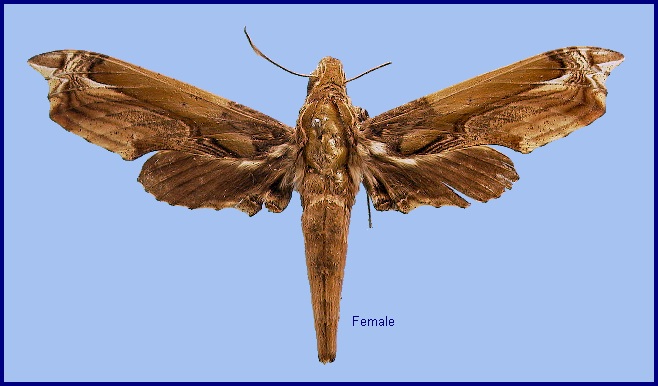
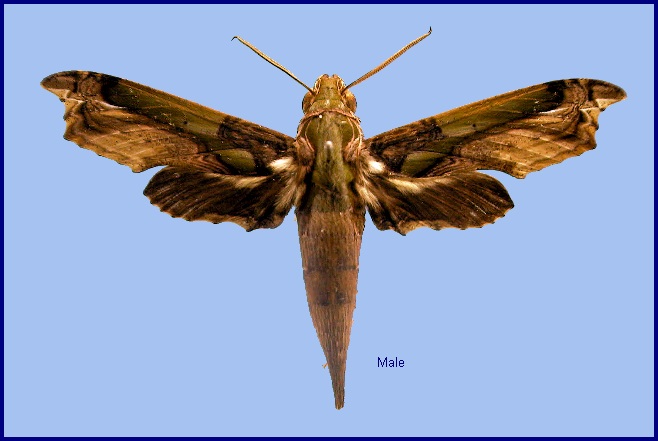
Panacra busiris Walker, 1856, List Specimens lepid. Insects Colln Br. Mus. 8: 158. Type locality: [Bangladesh,] Silhet [Sylhet].
Synonym. Panacra busiris Walker, 1856.
Wingspan: 68--82mm. Forewing upperside with space between antemedian and postmedian lines green, like upperside of head and thorax, contrasting with the rest of the wing. The vivid green colour on the upperside of the head and thorax, and the characteristic green area on the forewing comprising a broad costal band with a lobe extending towards the hind margin should make this subspecies unmistakable; however, in dried specimens (and even some live ones) this green colour may fade to brown. In the other subspecies of Eupanacra busiris the colouration is duller. Of the other species, only Eupanacra splendens shows a similar pattern, though much less well defined, but is readily separated by the broad orange band on the hindwing upperside. Distal margin of forewing deeply sinuate, the apex more produced than in other Eupanacra; the angle at vein M2 more acute in males than most females. Hindwing narrow, the costal margin clearly dilated near the base.
In the male genitalia, uncus rather short and broad, not much longer than gnathos. Gnathos tapering. Valve with numerous small stridulatory scales. Harpe similar to Eupanacra regularis regularis in lateral view, but less curved. Phallus apical process with the two slender, dentate, approximately equally wide lobes, arising from a short common stem, left much longer than the right with the serrate apex oblique so as to face the exterior; right process acute.
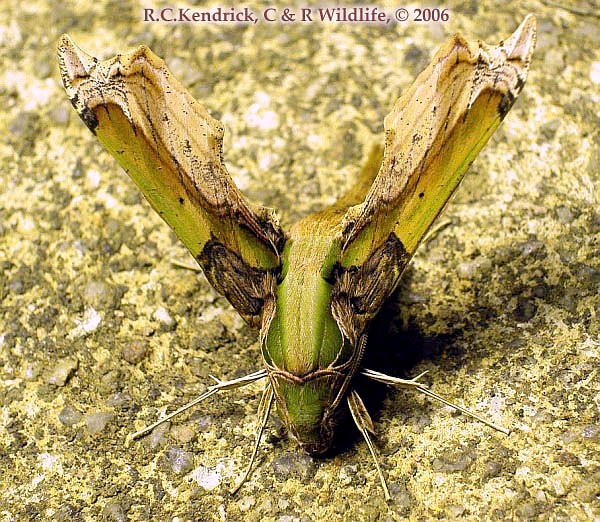
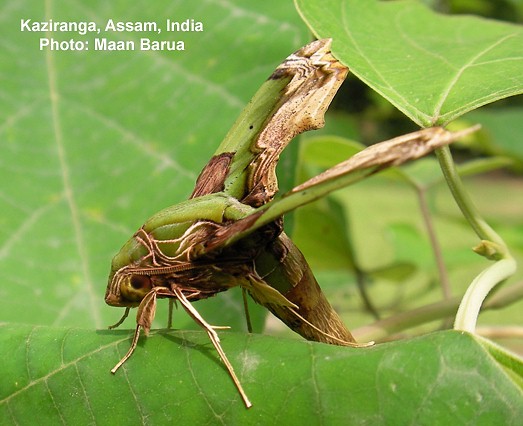
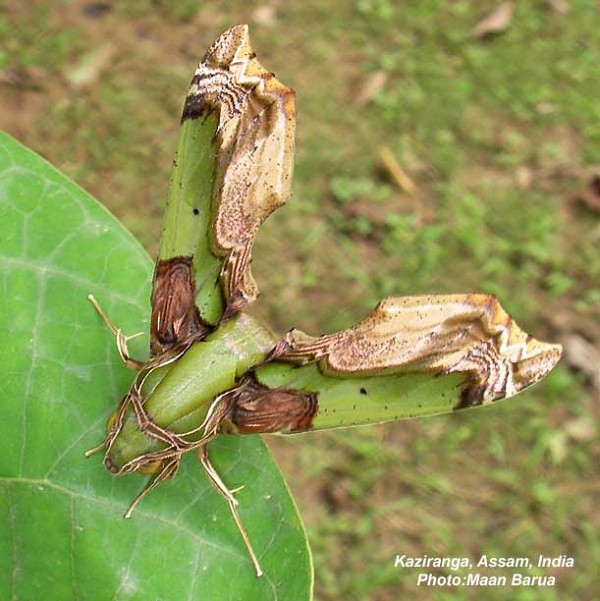
Flies at dusk. Attracted to the flowers of Duranta erecta but rarely to light (Tennent, 1992).
China: 23.i (Hainan); 2.iii (Guangdong); 24.iii (Hong Kong); 12.iv (Yingjing, Ya'an); vii (Guangdong; Yunnan); 1.viii (Hainan); 4.viii (Hong Kong); 25.viii (Yunnan); 27.ix (Guangxi); 22.xi (Yunnan).
Kendrick (2002) states that it is possibly trivoltine in Hong Kong, occurring from late March until late August.
OVUM: Pale brownish-yellow, spalshed with a little red. Oval (2.00 x 2.2mm), shiny and smooth, but under the microscope seen to be very superficially sculptured like the skin of an orange (Bell & Scott, 1937).
LARVA: Full-fed 85--90mm. According to Bell & Scott (1937), in Eupanacra busiris atima head small, semi-elliptical in shape, vertex flattened; true clypeus about one-half length of head, basal angles broadly rounded, apex acute; false clypeus with apex broadly rounded, reaching to two-thirds length of head ; labrum about one-half length of true clypeus; ligula longer than labrum, semicircular, with a very deep sinus; eyes with 1 to 4 equidistant in a sharp curve, 6 in line with 3 and 4 and twice as far from 4 as 4 is from 3; 5 forming an equilateral triangle with 4 and 6. Surface of head slightly shining, covered sparsely with minute glassy tubercles; basal half of labruni longitudinally striate. Body dull except for the enamel-like surface of the ocellus. Horn of medium length, slightly down-curved, somewhat flattened laterally, thick at base and tapering evenly to a sharp point; covered sparsely with minute tubercles.
Head pale olive-green with subcutaneous dusky dots; false clypeus edged narrowly with white, labrum glassy-white, the basal half suffused with pale fuscous; ligula reddish-brown; basal segment of antenna greenish, other segments reddish-brown; mandible pale rusty with tip broadly reddish-brown. Body rich olive-green, segments 2-4 and the dorsum of the remaining segments up to 12 suffused with pale brown; 13-14 yellowish-brown; a narrow brown dorsal stripe on 3 and 4, continuing as a series of brown spots near the front margins of 5-11; a narrow dark brown dorso-lateral stripe on 2-4; a broad, pale, yellowish brown spiracular stripe from the front margin of 2 to the spiracle of 5, which it surrounds, and continuing as a waved stripe on 7-10; a large eye-spot behind the front margin of 5, centre round and black, bordered behind and below broadly with dark brown and then narrowly with pale brown; the area between the eye-spots spotted with white. Horn olive-green, tip shortly yellow; legs yellow, prolegs pale brown; venter olive-green, suffused with blackish on 2-4. Spiracles oval, flush, pale yellow with a brown suffusion across the middle (Bell & Scott, 1937).
The young honey-coloured larva is very difficult to detect, as it lies along the midrib on the underside of a tender whitish leaf. In the first instar the long black horn is moved freely in a vertical plane when the larva is moving. In later instars the green and brown coloured larva lies during the day along the stem of the food-plant or on an adjacent tree-trunk, where it is also very difficult to detect. It appears to feed mostly at night (Bell & Scott, 1937).
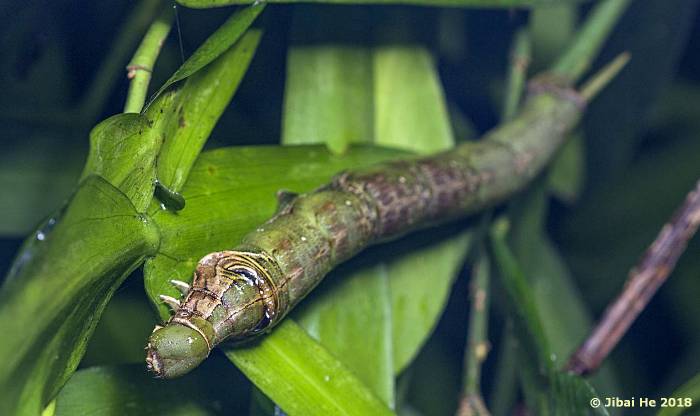
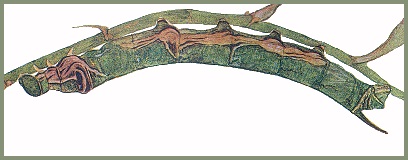
PUPA: 55mm. According to Bell & Scott (1937), in Eupanacra busiris atima this is slender in build; tongue-sheath narrow and keeled in front, widening basad, semicircular in lateral aspect; a large deep depression, invisible from above, between the base of the sheath and the eye. Surface dull; base and venter of tongue-sheath deeply corrugate, rest of body covered with low rounded ridges and tumidities; the front bevels of segments 8, 9 and 10 transversely ridged with narrow parallel lines. Spiracle of 2 a narrow slit, with a raised oval lobe projecting from the front margin of 3 just touching it; other spiracles broadly oval, the central slit with narrow, raised edges lying in an oval depression. Cremaster an equilateral triangle with the apex broadly rounded-truncate, the sides, seen from the dorsal aspect, in the same line as the sides of segment 14, so that it appears to be a continuation of that segment; the ventral surface deeply, longitudinally concave, the concavity continuous with a round axial depression in the hind end of 14; four pairs of strong, chitinized, bifid shafts, each arm ending in a hook, one shaft subdorsal at apex of cremaster, one lateral and one dorso-lateral farther forwards, and one subdorsal farther forward still, the apical pair the stoutest and branched well above base, the other pairs branched shortly above base.
Colour grey splashed and dotted with fuscous; front of tongue-sheath pale orange dotted with fuscous; wing-cases and abdomen marked with black strigae; a black interrupted ventral stripe on segment 9, 10 and 11; spiracles, spiracular lobe of segment 3 and cremaster dark reddish-brown.
Pupation takes place in a rough cocoon on the surface, formed of leaves etc. held together with coarse strands of silk, with a pad of silk at one end in which the hooks of the cremaster are entangled.


Larval hostplants. Lasia and Pothos scandens (Araceae) in India (Bell & Scott, 1937).
China: Sichuan (Yingjing, Ya'an); Yunnan (Menglun, 500m; Maguan County, Wenshan Zhuang; Xishuangbanna Tropical Botanic Garden; Wang Tian Shu); Xizang/Tibet; Guizhou; Guangdong (??Wa-Sha-Tai; ??Hast River Mts., 340m; Gaoyao; Luofu Shan; Jiantou; Shenzhen); Hong Kong; Guangxi (Longsheng; Nonggang); Hainan (Tianchi; Wuzhishan National Nature Reserve).
Nepal, Bhutan (Irungbam & Irungbam, 2019), northeastern India (Subhasish Arandhara, 2016), Burma/Myanmar, Great Nicobar Island (Singh, Ahmad & Chandra, 2021), Thailand, southern China, Laos, Vietnam (Le & Vu, 2024), Malaysia (Peninsular, Sarawak), Indonesia (Sumatra, Java, Kalimantan).
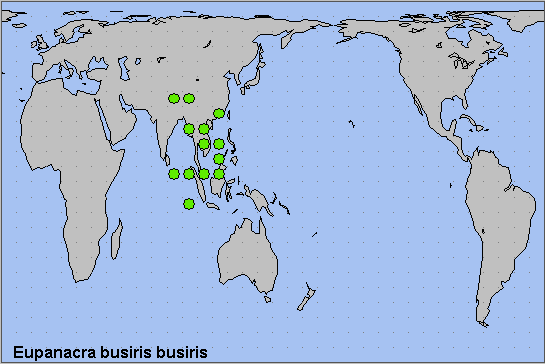
 Return to Sphingidae of the Eastern Palaearctic species list
Return to Sphingidae of the Eastern Palaearctic species list